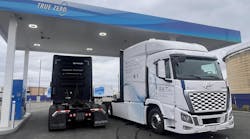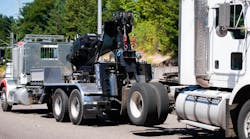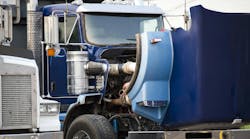Trucking is not an industry. Rather, it is a collection of diverse industry segments that use trucks to achieve their business objectives. In that vein, FLEET OWNER has begun a series of vocational profiles that will "popcorn" the trends and issues specific to various vocational niches. This month, we begin the first of these profiles with a look at what's happening in the air cargo and expedited motor carrier business.
Thursday afternoon, the phone rings. On the other end is an air-freight forwarder looking to get a set of dies to a plant manager in Sacramento. If they're not there by 6:30 the following morning, the plant risks shutting down a complete shift. Or more.
Minutes later, another phone call. This time it's Gateway, the direct marketer of personal computers. A customer has ordered a home computer and Gateway needs it delivered and installed the following day. And don't forget the trash.
Scenarios such as these repeat themselves daily at the thousands of motor carriers struggling for a toehold in the turbocharged world of air cargo and expedited freight.
It's not a business for the faint of heart. You never know from one minute to the next what you'll be hauling where and when. You have to have access to a wide variety of equipment to wrap the right kind of unit around the load right now. But you can't have so much that it sits idle for too long. Increasingly, you have to operate in a new electronic world in which real-time shipment tracking is the norm. The customers don't want excuses; they want performance on time, every time.
But despite the uncertainties, it's a market in the midst of tremendous growth. In fact, digesting this growth is proving to be a major issue for many carriers (see sidebar). Even without the UPS strike, this market segment was choking on the amount of freight it had to handle. According to DRI/McGraw-Hill, the business will grow 6.7% annually from 1994 to 2004, mainly from the continuing shift to higher value manufacturing.
The expedited freight market has in equal measure benefited from and driven the new economy's focus on lean inventories moving with greater velocity and just-in-time (JIT) manufacturing. "With these manufacturing and inventory control programs, companies are more frequently requiring urgent and unscheduled freight shipment to maintain production schedules or meet customer demands for product deliveries," according to a Con-Way NOW study. "While an estimated 25% of all freight moved on a JIT basis in 1995, this figure is expected to increase to 50% within five years."
In addition, shippers' demands for increased flexibility and faster service are driving the growth of the expedited freight market. This has led to transportation more often being purchased based on transit time and service, instead of on the historical shipping practice of selecting a transportation mode.
Con-Way NOW is one of the newer entrants into the business, exporting its expertise from its LTL roots under the Con-Way Transportation Services umbrella. "The environment for an expedited freight carrier requires a different infrastructure than that of a traditional regional LTL provider," says Ed Conaway, vp and general manager of the company. "The expedited freight industry is driven by immediate response and service availability, exclusive-use equipment, direct door-to-door deliveries, and the real-time collection and dissemination of shipment information."
The fleet is supported by a PC local area network that supports satellite tracking and voice/data communications systems. This allows Con-Way NOW's central command center to provide shippers with immediate and accurate information on shipment status, track the location of the NOW fleet, and communicate with contractors on a real-time basis.
The fleet consists of a pool of contract owner-operators, with five different vehicle configurations ranging from a cargo wagon to a tractor-trailer combination. The company has found that owner-operators offer the most flexibility and the best customer service. Adopting this strategy allows the company to match each shipment with the most appropriate and cost-effective equipment.
So tight are the service demands that Con-Way NOW promises to deliver shipments within 15 minutes of a quoted arrival time to qualify for on-time service. If a shipment is more than two hours late, freight charges are sliced by 50%. If it's more than four hours tardy, the shipment is free.
Like Con-Way NOW, Shaker Express in San Diego determined that ownership was not synonymous with service. In fact, years ago it impeded president Rocky Wilson from meeting his goals. That's when Wilson turned his fleet over to Penske Truck Leasing.
The reason? "We couldn't get the right kind of service, maintenance, or repair on our units," he explains. "It was not uncommon for a truck with a broken axle to sit in the shop for three weeks. That meant we had to rent equipment to get the freight delivered. That jacked up our costs so we started looking for alternatives."
When Wilson opted for leasing, he realized that although "we would pay a small percentage more," leasing would result in greater reliability and the assurance that somebody is looking at the units each day. Today, his 12 tractor-trailers and 16 24-ft. straight trucks are running on a five-year lease. Wilson also operates three Econoline vans that are on lease from a local automotive dealer.
On the newer medium-duty products, he has begun spec'ing automatic transmissions. Although the hoped-for fuel economy benefits have been illusory, an unexpected benefit has surfaced. "Our drivers love them," says Wilson. "With 15 stops likely in the course of a typical day, the automatics relieve a lot of stress and keep the driver fresh throughout the tour of duty."
With Penske capturing valuable operating information back on his vehicles, Wilson was able to stretch equipment turns by one year. Since the average length of haul was less than 50 miles, he was hard-pressed to hit one million miles with his entire fleet in the course of a year. "We were under-utilizing our fleet, so by extending that out we were able to reduce the lease rate without compromising service," he says. "If I have a service failure because of a breakdown four or five times in a year, that would be a lot."
Wilson also has contracts with 19 owner-operators. A former owner-operator himself, he would love to use only leased contractors. That would enable him to recapture the 5% of his revenue that is paid out in overtime to company drivers. "They have the incentive to sell and hustle - and keep me out of overtime situations," he says. "But the quality is not always as good as what you have with your own drivers, whom you can control and train" (see sidebar).
Although his fleet has not grown by more then 10 units, a heavy commitment to technology has allowed Wilson to bump up utilization. And more changes are in the offing, such as scanners that generate real-time electronic proof of delivery and capture electronic signatures.
"Five years ago, very few truckers offered electronic proof of delivery, status reports, and electronic tracking and tracing," says Shaker Express' Rocky Wilson. "Today, there are very few who don't."
Technology is also on Kevin Maloney's frontburner. Maloney is president of Northeast Express Transportation, a company that is comprised of three operating divisions: NEXTAir, an air freight pickup and delivery operation; NEXTCourier, an interoffice carrier for banks, utilities, and other businesses featuring regular scheduling; and NEXTDistribution, offering regular route service to retail customers and pharmacies.
"The common thread is time definite delivery and expedited service," says Maloney. "The demands of the customer dictate our equipment configuration, which is comprised of 30 vans and 30 straight trucks that bear the service marks of one of the three divisions, but can be put into service to handle the needs of any of the three."
Independent contractors operate all the equipment, although Maloney is discriminating on the age and look of the equipment. "We want the equipment to be white so we can apply our service marks," he says. "Plus it must be late model and well-maintained. We have a reputation to maintain and cannot afford to disappoint our customers since we are ultimately responsible."
Both the courier and distribution business have been growing well - doubling within the last three years. With both offering regular route deliveries, that has provided a solid foundation from which Maloney can target the more volatile air freight segment.
Maloney credits that growth to an obsession with customer service. "We measure the quality of our product and share that with the customer," he says, "so that the quality of our service and the perception of that quality are the same." He provides reports on the timeliness of deliveries once a week to his customers.
Within the past year, he has equipped his drivers with palm-top computers, which he helps pay for. The palm-tops tap into a digital cellular network to provide real-time updates of shipment status, cutting phone volume by more than half. Not only will the cost of customer service be reduced, the number of transcription errors will plummet, Maloney predicts.
"It's been a tremendous marketing tool for us," he says. "A lot of people can get freight from point A to point B with a modicum of efficiency. Technology sets us apart." So firmly is Maloney devoted to pushing the technological envelope that he is leading the first major rewrite of software for the air freight industry to communicate shipment status to the customer. "One of the reasons," he explains, "is to give our customers a leg up on their competition."
Shippers want all these performance guarantees, but not many are willing to pay for them. "We are trying to provide cutting-edge technology and compete with the mom-and-pop enterprise that is unable to operate at our level," Wilson complains. "Shippers may choose not to use these guys, but they sure do talk about our competitors' price sheets."
Such rigid performance expectations as are present in the expedited freight business turn on the ability to attract and retain motivated drivers.
"Drivers are our greatest asset," says Gerald Zubey, fleet manager for T&N Van Services, a commercial mover based in Moorestown, N.J., specializing in computer equipment relocations, and automatic teller machine installations. T&N operates a fleet of 35 trucks, 21 of which are 22-24-ft. straight trucks; the remainder are tractor-trailers.
"Drivers have to interact with our customers on a regular basis," according to Zubey. "They have a responsibility to pick up, move, and set up some pretty big-ticket items so they have to have the complete trust of the customer." The firm averages 40 ATM installations a week.
To help ensure this relationship, Zubey insists his drivers wear uniforms and have the right kind of equipment to protect the computers, copiers, and ATMs that are the staples of his business, as well as the right kind of training to install them upon delivery.
That's why each of the company's straight trucks are equipped with liftgates, to make the moves easier and "to enable us to do what our customers want," the fleet manager says.
Rocky Wilson, president of Shaker Express, sets high expectations for his 70 drivers. For instance, they have to have a clean MVR. "If they have more than one point, a DUI or a failure to appear, we won't hire them," says Wilson. "If they have an accident in the first 90 days, or two points and two accidents over a three-year span, they're given their walking papers. Drivers are docked three days for even a minor fender-bender."
The message is simple: "Drivers have to be accountable for their actions," says Wilson. "Accidents cost us money whether or not they're our fault, and we want to make sure the driver shares in that."
So far this new accountability is paying off: The number of fender-benders has been reduced from an average of three a week to not even one accident during the past year.
Not only are the safety standards high, so, too, are the technological demands. "There is certainly more demand to be conversant with technology in our marketplace," says Kevin Maloney, president of Northeast Express.
Trucking has long been held as a barometer of the nation's economy. Because the air cargo and expedited motor carriers are so tightly linked with the new economic forces, many analysts see this segment as even an earlier warning.
If that's the case, then the nation's economists will enjoy hearing that, at least for the short term, most carriers are still enjoying strong growth. "We've just completed the strongest June and July on record," reports Ed Hogan of HBI Priority Freight & Messenger Services in Herndon, Va. "We've been busy with existing business and new business."
How long it will last is still an open question. "We are gearing up for a substantial slowdown in the fourth quarter," Hogan continues. "Inventories are flush and the home-computer market (which comprises 80% of his business) is becoming saturated."
Air cargo and expedited motor carriers face a number of challenges specific to their end of the business. The following is a quick look at some of the biggest:
Cargo security. In the wake of the crash of TWA Flight 800 and subsequent air disasters, federal regulators are looking to beef up security of cargo traveling by air. Specifically, the Federal Aviation Administration is drafting proposals that could require more paperwork certification for shippers, carriers, and cargo. For motor carriers, such rules likely would beef up driver training requirements, mandate more thorough background checks, and require vehicle tracking capabilities and improved security on the trucks and at warehouses.
Cargo claims. The industry is also monitoring efforts by air-freight forwarders to force truckers to be totally liable for cargo theft and damage.
Credit. As the business has boomed, carriers are finding it tougher to check the creditworthiness of customers and potential customers. Plus, since the client base consists of huge entities such as airlines and air-freight forwarders, they're not always compelled to provide credit history to small trucking concerns. The Air and Expedited Motor Carriers Conference of the American Trucking Assns. is exploring the possibility of establishing a credit-reporting program so carriers can share information about creditworthiness.
Growth. It's rare that you hear anybody complain about growth, but it has become a big issue in the expedited carrier industry. Upgrading the fleet to handle the increase in business is tricky at best. Because the shipments can't wait, carriers must have the right kind of equipment to handle the business.
Technology. By its very definition, time-definite transportation raises the ante in terms of knowing where the load is and when it is due to arrive.
Consolidation. In a market populated by 10,000 generally small- and medium-sized carriers, and with none of those controlling more than a 2% market share, conditions are ripe for consolidation to achieve economies of scale.
Hours of service. Since there is little regularity or predictability in their business, air cargo carriers would benefit from more flexibility in daily driving limits.


